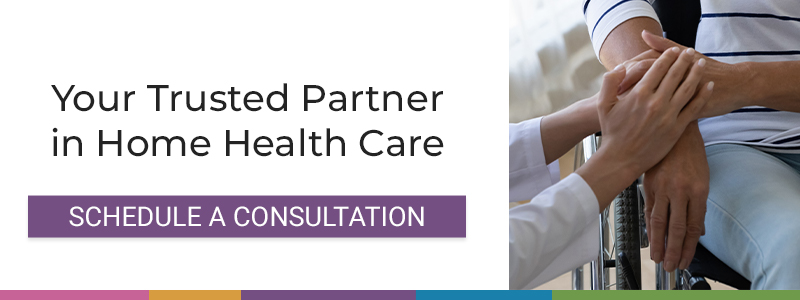If you have a loved one who is an older adult, you may be on high alert for life-threatening diseases such as strokes. After all, the risk of a major stroke nearly doubles for each decade after age 45, which means that the elderly may be particularly susceptible to this kind of disease.1
This is true of more serious strokes as well as mini strokes (or warning strokes). Although mini strokes can occur over a shorter duration and with more temporary symptoms, they can also signal the onset of more severe events in the near future. To learn more, visit our post discussing life expectancy after a stroke at 70 as well as the causes of a stroke in the elderly.
If you or your loved one has experienced a stroke, that doesn’t mean the power is out of your hands. Start by equipping yourself with the knowledge and tools needed to look out for the ones you love. In this guide, you’ll learn more about the signs of mini stroke in elderly people so that if you ever witness such symptoms, you can be sure to get them the medical care they need and strive for the best health outcomes possible.
What Is a Mini Stroke?
In general, both mini strokes and strokes are events that affect the blood flow to and within the brain. To better understand mini strokes, let’s first take a look at these two main types of strokes:2
- Ischemic (blood clot) – By far the most common type, affecting just under 90% of stroke patients, this occurs when a blood vessel is obstructed, or blocked, preventing it from providing blood supply to the brain.
- Hemorrhagic (bleed) – Affecting just over 10% of stroke patients, this type is caused by the rupture of a blood vessel in the brain, resulting in the accumulation of blood supply and the compression of brain tissue.
The medical term for a mini stroke is transient ischemic attack (TIA). This is a subtype of the common ischemic stroke but differs in length and severity. In other words, the blockage that restricts blood to the brain is short-lived and causes symptoms for approximately five minutes or less.
But, you shouldn’t be fooled by the name of this type of stroke or its seemingly mild symptoms. In fact, healthcare professionals typically call TIAs warning strokes. This name is more accurate because these events can be a warning for something more severe:
- A large percentage of people who have a significant stroke report experiencing a mini stroke first
- Up to ⅓ of people who have a mini stroke will have a more severe stroke within the year3
Thus, it’s important to remember that a mini stroke is a medical emergency that should not be overlooked.
Mini Stroke Symptoms
Because transient ischemic attacks are still strokes that prevent blood flow to the brain, mini stroke symptoms in the elderly are the same as any other stroke symptoms.
The major difference between mini stroke symptoms and symptoms of other strokes is duration. Ischemic or hemorrhagic strokes can cause symptoms that last hours or days as well as the potential for long-term brain damage. Mini stroke symptoms, however, are far less prolonged, typically lasting around 5 minutes.
Mini strokes can occur undetected, but typically cause recognizable stroke symptoms that will be noticeable to attentive onlookers.
#1 Numbness or Drooping
Sudden and unexplained numbness, weakness, or drooping in the face, arms, or legs is perhaps one of the most telltale signs of a stroke.
During a mini stroke, the lack of blood and oxygen to the brain can affect its ability to process sensory input, affecting muscles, nerves, and skin. Because strokes typically affect one side of the brain, it is very common for this symptom to impact only one half of the body.
This can look like:
- A lopsided grin
- Abnormal facial movements when talking or eating
- Drooling
- Weakness in arms or legs
- Inability to lift or move arms or legs
- Loss of balance or coordination
- Trouble walking
#2 Difficulty Speaking or Seeing
In addition to the visually apparent symptoms above, strokes can also affect cognitive function.
The most common cognitive symptom is disrupted speech. A lack of blood and oxygen to the brain can also affect the muscles associated with speech (such as the tongue and lips) and interrupt important speech-related signals from the brain.
The most common speech problems associated with strokes are:4
- Dysarthria – This is when someone cannot speak clearly and/or slurs their words. They might speak too slowly or inaudibly, or their words may not be understandable at all. Dysarthria is the most common speech symptom in the early stages of a major stroke.
- Aphasia – This refers to a broad range of language processing issues. A person experiencing aphasia may experience difficulty with the input and output of information. Aphasia can manifest as nonsensical jumbles of words, made-up words, or an inability to speak.
- Apraxia – A more physical than cognitive speech issue, apraxia refers to problems with tongue and lip muscles, which can affect the ability to speak understandably.
Strokes can also cause sudden and unexplained vision loss.
Vision can refer to the images we see that correspond to the physical world, but it also includes:5
- Object identification
- Facial recognition
- Visual-spatial awareness
#3 Confusion
Related to speech symptoms, someone experiencing a stroke may be likely to be extremely confused.
Confusion due to a stroke can come on suddenly and in the middle of an activity, rendering the person unable to think, speak, or understand what is being said to them.
#4 Severe Headache
Although a serious, painful headache might be attributed to a variety of ailments, a debilitating headache that comes unannounced and without any other explanation could be a symptom of a stroke.
A stroke-related headache causes pain that is sudden and extreme. This is different from a migraine-related headache, for example, which begins as a throbbing pain that gets progressively worse and comes with a variety of additional sensations (such as the feeling of tingling skin and seeing auras).
Act FAST
The American Stroke Association recommends that people who may be witnessing a stroke to “Act FAST.” This is a way to remember the most common and obvious symptoms of stroke and to act quickly in order to prevent severe long-term consequences.
The acronym FAST helps you ask questions about the person you are concerned might be having a stroke:
- F (Face Drooping) – Is one side of their face drooping? If you ask them to smile, is their smile crooked?
- A (Arm Weakness) – Are they complaining of weakness or numbness on one side of their body? If you ask them to raise their arms over their head, does one arm remain at their side?
- S (Speech Difficulty) – Is their speech slurred or abnormal? Are they struggling to answer basic questions about their life, their surroundings, or the task at hand?
- T (Time to call 911) – Call 911 immediately if you answer yes to any of the above questions.6
Recovery and Life Expectancy After a Mini Stroke
Although every person’s prognosis after a mini stroke is unique based on a myriad of individual health factors, being able to recognize a mini stroke and get medical attention can be extremely beneficial for long-term wellness.
It’s important to get someone having a stroke to the hospital as quickly as possible (preferably by ambulance) so that life-saving interventions can take place. For ischemic mini strokes, patients can receive medicine to destroy the blood clot or blockage obstructing blood flow.
Even though mini strokes might appear mild, receiving immediate medical care and possible treatment is vitally important. Because mini strokes can also be thought of as warning strokes, medical interventions can help prevent more severe strokes in the future. This might, at the very least, push doctors, patients, and their families to work together to be proactive and more aptly prepare for situations that may arise in the future.
Preventing Mini Strokes
While strokes are very common, particularly among the elderly, stroke prevention can limit the risk of mini strokes as well as more severe strokes.
The Centers for Disease Control and Prevention (CDC) recommends that people follow the ABCS of stroke prevention:7
- Aspirin – Regular use of Aspirin can be an effective preventative measure. Aspirin cannot, however, be used to treat an active stroke.
- Blood Pressure – Be sure to consistently monitor and treat blood pressure levels with your doctor.
- Cholesterol – Through diet and medication (if needed), control your cholesterol levels.
- Smoking – The significant health risks associated with smoking have been known for some time now. Because smoking can cause significant cardiovascular distress, it can drastically increase the stroke risk.
Alliance HomeCare: Quality Care For Your Aging Loved One
With age, health issues and risks increase quite dramatically. Perhaps one of the most common and worrisome age-related diseases is stroke. But with the proper care, balance exercises for seniors, and attention, you can take the necessary steps toward achieving peace of mind.
With Alliance HomeCare, you can rest assured that our home care staff is knowledgeable about the signs and symptoms of a stroke. We can care for your elderly loved one in the comfort of their home and, if the worst were to happen, such as a mini stroke or a more severe stroke, our home medical assistance caregivers are trained to ensure that patients receive immediate medical attention.
If there are lasting effects from a stroke, caregivers can help the patient experience the benefits of home care and also provide treatment and recovery to manage symptoms and reach rehabilitation goals.
Contact Alliance Homecare today to find the home care your family needs.
Sources:
- The National Center for Biotechnology Information. Influence of Age and Health Behaviors on Stroke Risk: Lessons from Longitudinal Studies. https://www.ncbi.nlm.nih.gov/pmc/articles/PMC3006180/
- Centers for Disease Control and Prevention. Types of Stroke. https://www.cdc.gov/stroke/types_of_stroke.htm
- American Stroke Association. What is a TIA. https://www.stroke.org/en/about-stroke/types-of-stroke/tia-transient-ischemic-attack/what-is-a-tia
- WebMD. Stroke Recovery: Talking and Communication. https://www.webmd.com/stroke/stroke-talking-communication-issues
- Johns Hopkins Medicine. Stroke-Related Vision Loss. https://www.hopkinsmedicine.org/wilmer/services/low_vision/Stroke-Related_Vision_Loss_low_vision.html
- American Stroke Association. Stroke Symptoms. https://www.stroke.org/en/about-stroke/stroke-symptoms
- Centers for Disease Control and Prevention. Preventing Stroke: What You Can Do. https://www.cdc.gov/stroke/prevention.htm





